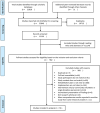Community-based rehabilitation services implemented by multidisciplinary teams among adults with stroke: a scoping review with a focus on Chinese experience
- PMID: 38454384
- PMCID: PMC10921794
- DOI: 10.1186/s12889-024-18218-1
Community-based rehabilitation services implemented by multidisciplinary teams among adults with stroke: a scoping review with a focus on Chinese experience
Abstract
Background: Despite the growing interest in hospital rehabilitation services for communities, studies on existing community-based rehabilitation (CBR) services remain scarce owing to limitations in the development of community health services and regional cultural diversity. As a guaranteed measure for ensuring the quality of rehabilitation services and achieving the desired service outcomes, clear roles and responsibilities in multidisciplinary teams and effective service delivery are particularly important.
Objective: This scoping review aimed to determine the scope of community stroke rehabilitation programs involving existing multidisciplinary teams and to analyze the implementation content and implementers' functional roles to provide guidance for future CBR programs.
Methods: The scoping review design followed the methodology of the Joanna Briggs Institute and was based on the normative scoping review framework proposed by Arksey and O'Malley. The comprehensive CBR framework was proposed by World Health Organization-guided data charting and analysis.
Results: Of the 22,849 identified citations, 74 studies were included, consisting of 6,809 patients with stroke and 49 primary caregivers, most of whom were from China. The most common working mode in CBR programs was a dual approach involving both healthcare professionals in medical institutions and community healthcare professionals. The number of programs in each discipline was in the following descending order: nursing, medical care, rehabilitation, psychology, nutrition, and public health. Among these, multidisciplinary teams comprising medical, nursing, and rehabilitation disciplines were the most common, with a total of 29 programs. Disciplinary members were mainly responsible for implementing their respective disciplinary content, with physicians providing guidance for the programs. More than 82.4% of the studies reported 2-4 intervention strategies. The intervention forms of rehabilitation content were the most diverse, whereas preventive interventions were more homogeneous than others. Physical function and socio-psychological measurements were the most commonly reported outcomes.
Conclusion: CBR services implemented by multidisciplinary teams can effectively achieve functional and emotional improvement in patients with stroke, and nurses are the most involved in implementation, especially in community settings. The results further emphasize the importance of strengthening the exploration of nurses' maximum potential to implement CBR plans in future practice.
Trial registration: The registration information for this scoping review can be found at osf.io/pv7tg.
Keywords: Adults; Community-based rehabilitation; Multidisciplinary; Scoping review; Stroke.
© 2024. The Author(s).
Conflict of interest statement
The authors declare no competing interests.
Figures









Similar articles
-
How has the impact of 'care pathway technologies' on service integration in stroke care been measured and what is the strength of the evidence to support their effectiveness in this respect?Int J Evid Based Healthc. 2008 Mar;6(1):78-110. doi: 10.1111/j.1744-1609.2007.00098.x. Int J Evid Based Healthc. 2008. PMID: 21631815
-
Community-based rehabilitation implementation for people with disabilities in South Africa: a protocol for a scoping review.Syst Rev. 2021 Oct 28;10(1):279. doi: 10.1186/s13643-021-01839-7. Syst Rev. 2021. PMID: 34711260 Free PMC article.
-
Beyond the black stump: rapid reviews of health research issues affecting regional, rural and remote Australia.Med J Aust. 2020 Dec;213 Suppl 11:S3-S32.e1. doi: 10.5694/mja2.50881. Med J Aust. 2020. PMID: 33314144
-
Structure and processes of interdisciplinary geriatric consultation teams in acute care hospitals: A scoping review.Int J Nurs Stud. 2016 Mar;55:98-114. doi: 10.1016/j.ijnurstu.2015.09.015. Epub 2015 Oct 9. Int J Nurs Stud. 2016. PMID: 26643445
-
Reducing unplanned hospital admissions from care homes: a systematic review.Health Soc Care Deliv Res. 2023 Oct;11(18):1-130. doi: 10.3310/KLPW6338. Health Soc Care Deliv Res. 2023. PMID: 37916580
Cited by
-
Effects of a multi-modal static and dynamic balance and hand function training program on multi-dimensional balance ability, hand function, and life-space mobility in rural older adults: protocol for a randomized controlled trial.BMC Sports Sci Med Rehabil. 2025 Jul 2;17(1):175. doi: 10.1186/s13102-025-01214-2. BMC Sports Sci Med Rehabil. 2025. PMID: 40604859 Free PMC article.
-
Healthcare professionals' knowledge and perceptions of post-stroke rehabilitation in the peripandemic period: an online cross-sectional survey.Rheumatol Int. 2024 Dec;44(12):3063-3071. doi: 10.1007/s00296-024-05746-7. Epub 2024 Oct 26. Rheumatol Int. 2024. PMID: 39460762
-
A scoping review of stroke rehabilitation in Africa: interventions, barriers, and research gaps.J Health Popul Nutr. 2025 Jul 10;44(1):245. doi: 10.1186/s41043-025-01004-z. J Health Popul Nutr. 2025. PMID: 40640909 Free PMC article.
References
-
- Ma Q, Li R, Wang L, Yin P, Wang Y, Yan C, Ren Y, Qian Z, Vaughn MG, McMillin SE, et al. Temporal trend and attributable risk factors of stroke burden in China, 1990–2019: an analysis for the global burden of Disease Study 2019. Lancet Public Health. 2021;6(12):e897–e906. doi: 10.1016/S2468-2667(21)00228-0. - DOI - PMC - PubMed
-
- Teasell R, Salbach NM, Foley N, Mountain A, Cameron JI, Jong A, Acerra NE, Bastasi D, Carter SL, Fung J et al. Canadian stroke best practice recommendations: rehabilitation, recovery, and community participation following stroke. Part one: rehabilitation and recovery following stroke; 6th Edition Update 2019. Int J Stroke 2020, 15(7):763–788. - PubMed
Publication types
MeSH terms
LinkOut - more resources
Full Text Sources
Medical
Research Materials
Miscellaneous

